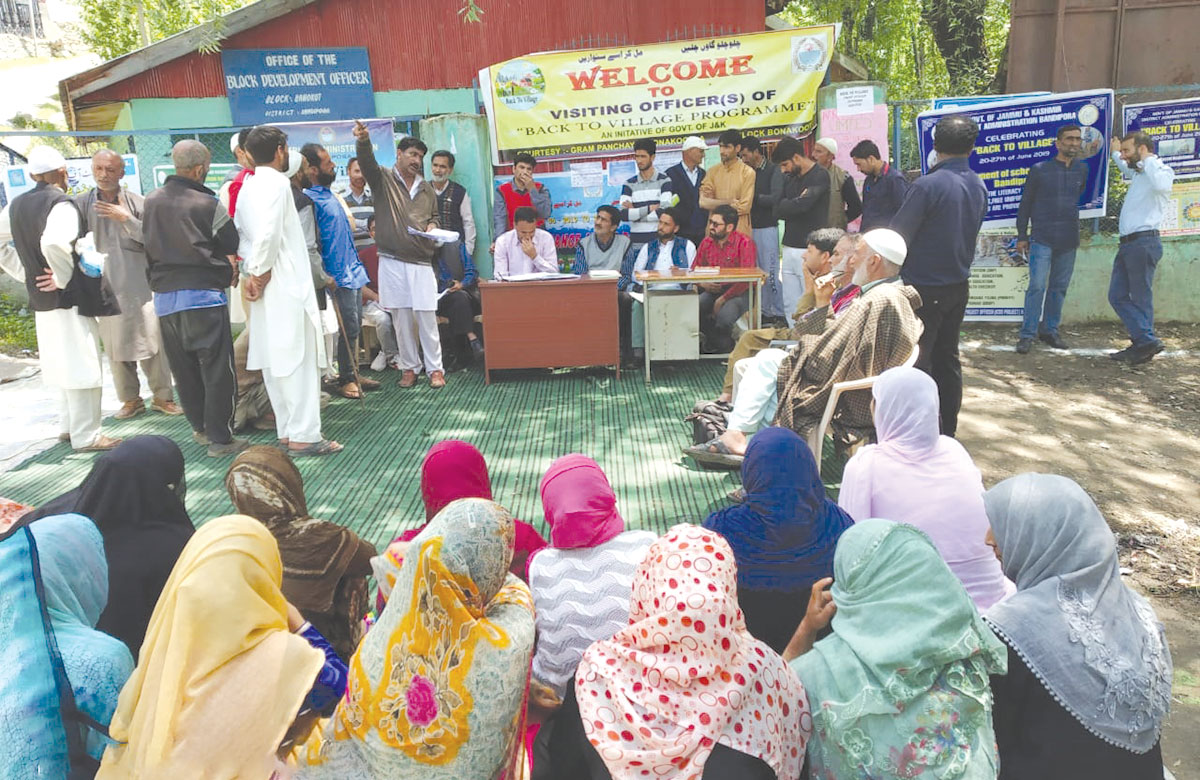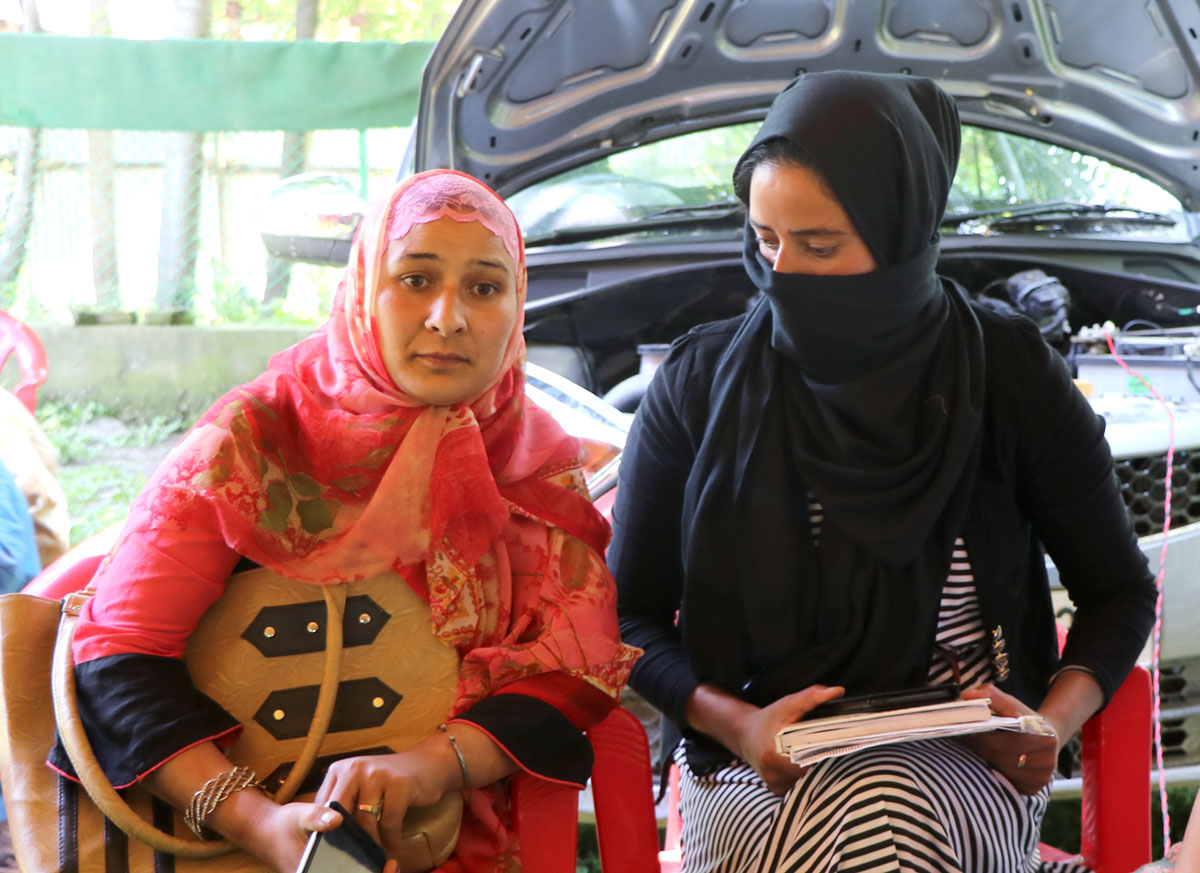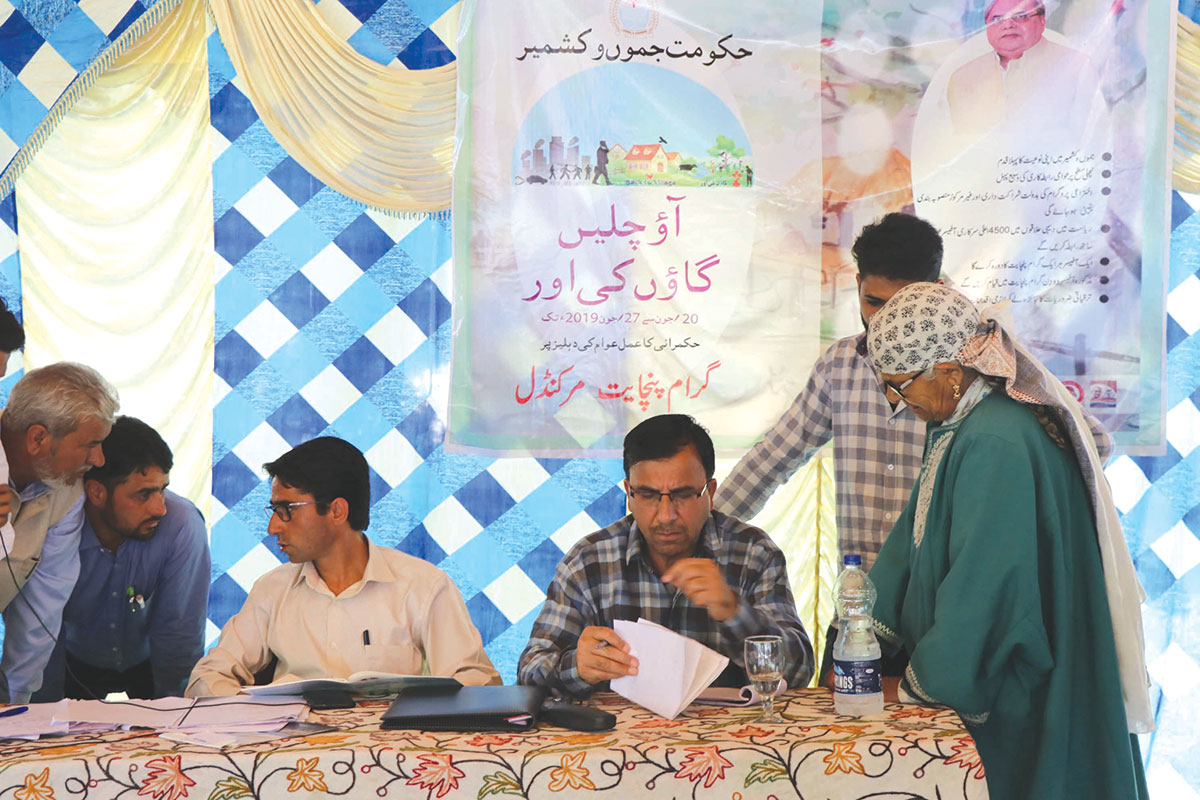As more than 4500 officers moved for an overnight stay in Panchayats between the Sino-Indian border and the Line of Control to listen to the grievances and check the service delivery, Shams Irfan, who participated in a series of such meetings in north Kashmir, reports the hope that Back To Village generated

At 10 AM, the small Panchayat Ghar in Sumbal’s Naninara is filled with hope as government officials representing different departments come face-to-face with residents under Back to Village initiative. Most of the assembled villagers had waited their entire lives for such an opportunity to get heard or they said so. They knew this is their chance and they said it.
With a population of over 300 souls, the male population in Naninara depend almost entirely on River Jhelum for livelihood. They would fish, extract nadru, the famous lotus stem, or work as labourers to help strengthen river banks under government’s NREGA scheme. Jhelum has remained central to their survival.
But given the change in weather and continuous flood like situation since 2014, Jhelum barely sustains families now.
“We live in perpetual threat of floods,” said Mohammad Yusuf Shah, 45, told representatives of Rural Development Department, seeking immediate attention. “This has pushed the entire area towards poverty,” he adds trying to convey the urgency of the problem.
To overcome the crisis, womenfolk in Sumbal, one of the most improvised belts in Kashmir, came together to form small Self Help Groups (SHG), under Government’s National Rural Livelihood Mission (NRLM), locally rechristened as Umeed initiative. This small initiative set the wheels of change in motion.
In Nainanar, there are 16 SHGs comprising ten members in each group. These women do Aari (embroidery) work, make curtains for clients, stitch clothes, bags, and bed-sheets, to help their families sustain financially. These products are then sold locally earning them a small amount and that supplements the modest family incomes.
At Back to Village interactions with officials, these young girls representing one group each, asked for a Training Centre, where they will be taught skills locally.
“We cannot afford to travel to Srinagar on a regular basis. If we had a Centre here, it would help us improve and earn better,” said Fatima Majeed, 23, a postgraduate and a Bachelors’ of Education from the University of Kashmir who does Aari work in her free time.
Interestingly, not far from Panchayat Ghar, a huge building was constructed some 12 years back. It was completed but never utilised for anything. Fatima and other members of SHG want this building to be turned into a Training Centre for Naninara and its adjoining village Tengpora.
“Such a Training Centre will help more local women get out of poverty and become independent,” feels Fatima.
A beneficiary of NRLM scheme, Fatima has applied for over two dozen jobs in the last two years after finishing her degree. “We see job advertisements in newspapers almost regularly. But once you apply, you have to wait endlessly for even an interview call,” Fatima told Shahnawaz Bukhari, the Sub District Magistrate, Sumbal, who oversaw the Back to Village programme in his area. “I don’t know what happens to our applications, as there has been no communication from governments. They just advertise jobs and then forget.”
As officials take note of Fatima’s concern, Bukhari seeks a list of the jobs she had applied for and assures her immediate follow-up.
But, like most of the young girls in Sonawari belt, sitting idle at home and waiting for a job is not an option for Fatima. She knows her labourer father cannot provide for a family of seven for long. “We have to do something to keep going,” said Fatima in a matter of fact tone.

Under NRLM, a Government of India scheme aimed at poverty eradication and women empowerment, Fatima was given financial assistance of Rs 15000 and Rs 40,000 in two instalments. She and other SHG members apprised NRLM official, who was there under Back to Village, about their pending third instalment of Rs 25000. “We have not received funds from the Government of India so far. But once we get it, you will receive the money in your accounts within no time,” assured Arif Rashid, Block Programme Manager NRLM.
Apart from procuring raw material for herself, Fatima utilized the money to open a cosmetic shop in Sumbal. This has raised hope for other girls who have registered with NRLM.
Back to Village initiative is the governor Satya Pal Malik’s administration’s flagship programme aimed at an outreach of the bureaucracy. It is aimed at interacting with the people, listening to their grievances and collecting certain basics from the Panchayats. It involved the deployment of more than four thousand gazetted officers to 4483 Panchayats and is apparently a follow up to the elections to the basic tier of governance. The Panchayats are getting a good amount of resource, mostly directly from the central government, and this initiative is aimed at assessing the requirements.
Officers from the top-level (Principal Secretaries) to the entry-level KAS officers, under this initiative, were deployed during the week-long programme to spend two days in a Panchayat. This, according to the initiative, must include a night-long stay. The initiative concludes on June 27.
“It is a unique and ambitious initiative, the first of its kind in Jammu and Kashmir,” said Rohit Kansal, Principal Secretary, Planning, Development and Monitoring. He is also the spokesman for the governor’s administration. “We have 4,483 panchayats in the State and every panchayat will be attended to by a gazetted officer.” This initiative is perhaps the first such exercise that witnessed such a huge number of officers travelling in the periphery. Certain areas might see the high-level visit for the first time.
Sheetal Nanda, state’s Rural Development Secretary said the officers are supposed to meet the panchs and sarpanchs, hold graam and mahila sabhas in addition to other grassroots level interactions.
“The basic objective of this programme is to move governance from its seat of operation to the doorsteps of the people in villages,” Nanda was quoted saying. “The officers will collect data on the guidelines contained in the 20-page booklet that has already been given to them.”
Chief Secretary BVR Subramanyam earlier said the programme is aimed at four main goals: energising panchayats, collecting feedback on the delivery of government schemes and programmes, capturing specific economic potential, and undertaking assessment of needs of villages.
Nanda explained that five main problems will be highlighted from each Panchayat. “After collection of the data, we will put it out on our website and respective administrative departments will be asked to attend to these problems on a top priority basis,” she was quoted saying. “The officer who visits the Panchayat will be designated as the Nodal Officer for that village.”
In the follow-up, the Nodal Officers will revisit the villages and take stock of the redressal of the problems.
With these objectives, the entire administration was busy – initially in preparations and later in its implementation. From Damchok on the Sino-Indian border to the Teetwal on the Line of Control, for the first time in history, every Panchayat had an officer visiting. Though they had no magic wand to solve the issues that people came up with, they listened, took notes, made assurances and promised to return.
Sonawari remained busy for both days. This was despite the fact that the speedy winds and fast rains disrupted these visits, but by next morning, the tents were filled with people in most of the Panchayats. The belt being one of the poorest in north Kashmir, most of the villages have a bulk of its population living below the poverty line. A doctor, who was part of the initiative, tells officials that not many Below Poverty Line (BPL) families know about Ayushman Bharat Gold Card, which entitles them to free health insurance cover worth Rs 5 lakh. “This needs to be propagated so that people can benefit from it,” she tells the officers.
In nearby Nesbal-Hilalabad village, a large tent was pitched inside a residential house’s compound. Headed by director Integrated Child Development Services (ICDS), the meeting was largely shadowed by local Panchs and Sarpanchs. In a corner of the tent, half-a-dozen young girls sat with their eyes fixed at the officers, waiting for their turn to be heard. These girls were part of local SHG. There are eighty women and girls connected with NRLM, distributed in eight equal groups. They utilize a different set of skills to help improve their lives.

For instance, Saiqa, an undergraduate student at Sumbal college, has utilized funds given by NRLM to upgrade her father’s traditional tailoring shop in the village. There are three tailor shops catering to four hundred households. But Saiqa’s father’s shop is the best one now, thanks to the financial assistance that helped her implement new ideas she picked up in Sumbal.
Saiqa is not the only beneficiary of NRLM in Nesbal-Hilalabad village. A number of government-backed interventions helped women take the centre-stage in family’s financial wellbeing. These girls were excited to interact with officials during Back to village programme and seek government’s intervention in connecting them with the markets outside Kashmir.
Most of these young girls are raised learning Aari work and other small crafts that help them add to family’s income when they grow up. But most of their income used to go into the pockets of middlemen and commissioning agents.
They used to exploit artisans like Saiqa and other girls who would work managing their time between college and examinations. For them, forming a SHG was the most liberating intervention they could see in a long time. And with financial help from NRLM, these crafts became the main source of their livelihood.
Once they freed themselves from the clutches of middlemen and commissioning agents, they seek direct access to the markets outside Kashmir. “We need a platform where we can sell our products directly to customers in places like Delhi and Dubai,” said Saima, 19, an expert in needlework on delicate Pashmina shawls. “I have learned this craft from my mother who in turn had learned it from her mother.”
But unlike her mother, Saima is aware of market, demand, and global appetite for Pashmina shawls. After completing a shawl, which takes over two months to finish as she has to devote time to studies, Saima doesn’t sell it to a middleman.
“Since becoming a member of SHG, I have learned how to connect with customers who do not exploit an artisan,” said Saima with a hint of confidence in her voice.
Both Saima and Saiqa have sacrificed their college and work to attend Back to Village programme hoping it will help them raise issues regarding their livelihood.
Same livelihood concerns have forced Gulshan Ara, 25, a trainee nurse at Jawahar Lal Nehru Memorial (JLNM) hospital, Rainawari, Srinagar, to attend the programme at her native village in Markundal.
After completing diploma in nursing from a Srinagar-based college, Gulshan rented a room in the old city so that she could attend her internship programme regularly. But the art of making a shawl, which she had picked from her mother, stayed with her. “My father is old and ill. He cannot support a large family of seven. So being the eldest, I had to earn to feed them,” said Gulshan. “I am here with the hope that the government will help us set up SHGs like other parts of Sonawari. So far, we are not part of NRLM scheme.”
Five months back when Gulshan moved to Srinagar’s city, she took a fresh Pashmina shawl along to work on. “After day’s work at the hospital, I work on the shawl which will fetch me Rs 8000,” said Gulshan. But given her engagements at the hospital, she is way behind the schedule. “I was supposed to finish it in two months, but it has been already five and I am only half done,” said Gulshan sadly. “It adds to the frustration.”
With ten years of experience, Gulshan is an expert in sozni, tilla and crochet work. “I have seen how these SHGs have changed the lives of other girls in this region. Why cannot we have something same in our village,” she said.
Sitting next to her, Haleema Begam, mother of three sons, nods her head in agreement. Over the years, Haleema has taken her craft to the next level by exhibiting her work in places like Delhi, Agra and Ajmer. She now outsources part of her work to girls like Gulshan who cannot dedicate themselves entirely to handicrafts because of other engagements. “I am trained in Sozni work. But if I need bags or bed sheets or other items, I outsource it to young and unemployed girls who want to make some money for themselves,” said Haleema. “I then take their work outside Kashmir and exhibit it on their behalf.”

Being a victim of middlemen and commissioning agents herself, Haleema wants a small centre in her village where she could train young girls. “I am here to tell officials how this small intervention can change thousands of lives and get hundreds of families out of poverty,” said Haleema.
Both Gulshan and Haleema are confident that their demands will be heard and acted upon by the officials.
However, before they could speak, an old lady walks towards the officers, who sat behind a big desk shaded by a make-shift tent and seek their help in releasing her monthly widow stipend. “I have visited a number of offices but nothing has happened. Now my only hope is this place,” she tells the officers. “See I am too old to travel to Sumbal to know its status every month. Please help me.”
Moved by her stooped frame and wrinkled visage, the officer orders his subordinate to work on her grievance immediately. “We have raised hope among people by coming to them. Let’s hope we can live up to their expectations,” said an officer at the end of an interaction with senior citizens.















